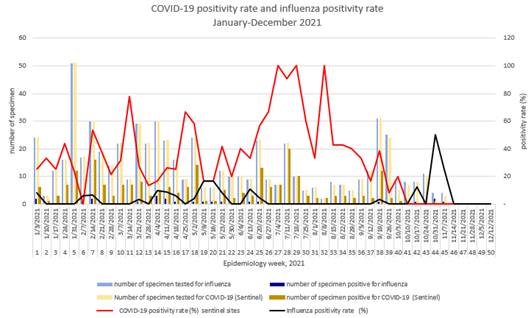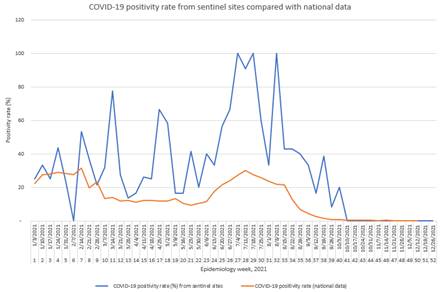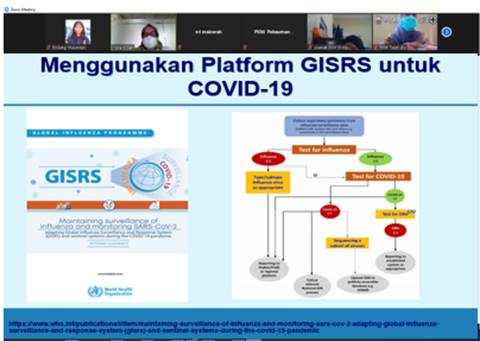As part of the pandemic influenza preparedness framework, WHO established Global Influenza Surveillance and Response System (GISRS), a global platform for monitoring influenza epidemiology and disease; and a global alert system for novel influenza viruses and other respiratory pathogens. Responding to COVID-19, WHO developed a guideline on maintaining surveillance of influenza and monitoring SARS-CoV-2. MoH adapted the guideline to monitor COVID-19.

Fig. 1. COVID-19 and influenza positivity rates from ILI/SARI sentinel sites, 2021 (Credit: Endang Wulandari/WHO).
Currently, there are 31 Influenza Like Illness (ILI)-based primary healthcare centers and 14 Severe Acute Respiratory Infection (SARI)-based hospitals as sentinel surveillance sites in Indonesia that are part of the GISRS network. The sentinel sites detect cases based on case definition, collect specimen samples and ship them to designated laboratories, record cases and send weekly reports. MoH collects, verifies, monitors completeness and timeliness of reports, conducts data analysis and uploads the data to GISRS platform (Flu ID and Flu Net).
To maintain ILI/SARI sentinel sites and expand their function to monitor COVID-19, besides influenza, WHO supported an orientation on the updated guideline, an online refresher training and review meetings, data collection and analysis, sample collection and shipment for ILI and SARI sentinel sites, and field monitoring and evaluation. A total of 30 participants from ILI and 52 participants from SARI sentinel sites attended the review meeting. Meanwhile, the refresher training was attended by around 100 participants. During field monitoring to 22 selected sentinel sites between March-November 2021, the MoH team delivered brief refreshment on case operational definition, sample collection and shipment and discussed gaps and challenges in implementing influenza surveillance.

Fig. 2. COVID-19 positivity rate from ILI and SARI sentinel sites compared with national surveillance data (Credit: Endang Wulandari/WHO).
Impacted by the pandemic, outpatient visits to ILI sentinel sites have decreased, leading to lower case detection and sample collection. Up to 19 December 2021, 647 specimens were collected and tested from ILI and SARI sentinel sites and 23 were confirmed influenza (3.6%). According to sentinel data, Influenza A(H3) was the predominant subtype between September and December 2021. Other confirmed subtypes include influenza A (H1) and influenza B Victoria lineage.
Among 98% (636 out of 647) specimens tested for COVID-19, 222 were confirmed positive for COVID-19 (35%). The positivity rate of COVID-19 from sentinel sites is higher compared with COVID-19 positivity rate from the national COVID-19 surveillance data. Overall, the COVID-19 positivity trend from sentinel sites is aligned with COVID-19 national surveillance data, increasing around June with a peak in mid-July and declining since August 2021. This indicates ILI/SARI sentinel surveillance can be used to monitor COVID-19 and provide input for policy decision making with maintaining and improving data quality, completeness and timeliness of reporting and specimen collection, shipment, and testing. Responding to threat of the COVID-19 Omicron variant, WHO technical briefing for COVID-19 Omicron recommends countries to conduct sequencing of samples from ILI and SARI sentinel sites as part of genomic surveillance strategy.

Fig. 3.WHO presented maintaining surveillance of influenza and monitoring SARS-CoV-2-2 during ILI/SARI review meeting (Credit: Endang Wulandari/WHO)
Implementing proper health protocols to prevent COVID-19 and influenza transmission is important. These include wearing a mask, washing hands, maintaining social distance, avoiding the 3Cs (spaces that are closed, crowded or involve close contact), keeping good hygiene, improving room ventilation and getting vaccinated.
Support for capacity building to improve Influenza Like Illness (ILI) and Severe Acute Respiratory Infection (SARI) sentinel sites activity has been made possible with the generous support of Pandemic Influenza Preparedness Framework (PIP) fund.
***

Health worker performed nasopharyngeal swab sample collection in Makassar City-Gowa Regency. (Photo Credit: Herwin Bahar/ via Getty Images)
